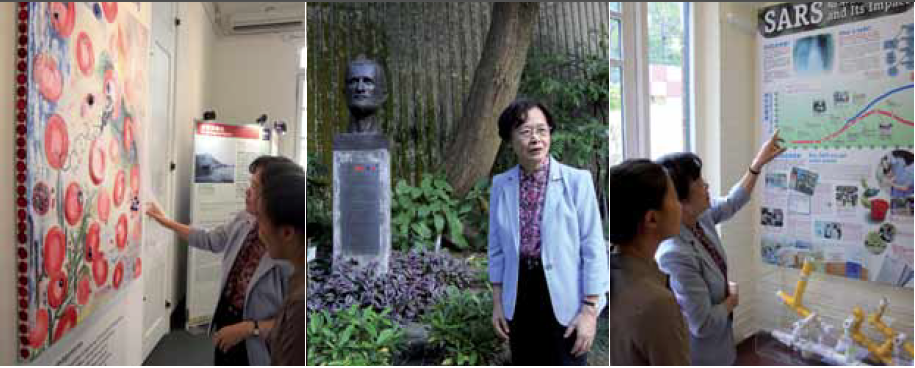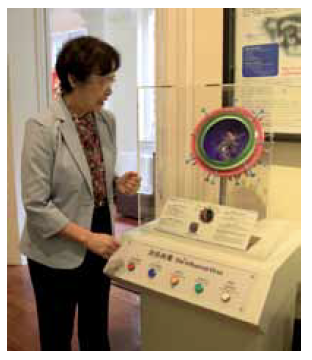© Hong Kong Academy of Medicine. CC BY-NC-ND 4.0
DOCTOR FOR SOCIETY
A glimpse into the past: rediscovering Hong Kong’s history of medicine with Professor Faith Ho
Kenny KH Chan1; Shadow YK Ng2; Vivian WC Yim2
1 Year 4, Faculty of Medicine, The University of Hong Kong
2 Year 4, Faculty of Medicine, The Chinese University of Hong Kong
If books are the bridges that connect us to the past
and the future, then museums are surely the portals
that bring us to experience them physically. This shining example of
Edwardian architecture on Caine Lane has stood the
test of time and witnessed the revolutionary reforms
of environmental and hygiene policies of our city,
revealing to us its manifold stories of Hong Kong’s
medical history. In the doorway stood Prof Faith Ho, former
Professor of Pathology at the University of Hong
Kong, who welcomed us and graciously
led us into the Hong Kong Museum of Medical
Sciences. As we sat down in the conference room
for tea, Prof Ho invited us to think of some reasons
behind the initiative that led to the establishment of
the Museum.
“What do you think is the raison d’être of the
Museum?”
While we all had different answers to the
question, we unanimously agreed that educating the
public about the medical history of Hong Kong is
probably the most important reason. Smiling gently,
Prof Ho patiently agreed that this was the most
logical response, but encouraged us to delve into this
issue as she guided us through the untold tales of the
Museum.
“The historical role of this building in
safeguarding Hong Kong’s public health has much to
offer,” Prof Ho remarked, “particularly in educating
health professionals and the public and, more
importantly, in preserving the cultural heritage of
Hong Kong’s medical development.”
The museum building has made its mark in
history as Hong Kong’s first purpose-built medical
laboratory, also known as the Bacteriological Institute,
built in response to the plague outbreaks starting in 1894, and opened in 1906. As newer facilities have been built over
the years, the Institute had fulfilled its historical role
and was decommissioned in the 1980s. When the
building became an officially declared monument
in 1990, Prof Faith Ho, who was the President of
the Hong Kong College of Pathologists at the time,
led an initiative to reinvigorate the monument and
petitioned the government to transform it into the
current Hong Kong Museum of Medical Sciences.
“The establishment of the Museum was a joint
effort with enormous support from our community.
I just happened to be in the right position at the right
time to do the right thing.”
As Prof Ho recounted the obstacles she and
her team had overcome, she repeatedly emphasised
that the success of the Museum was a result of the
collective effort by medical colleagues and the wider
community. As we asked why she opted to take up
the leadership in spearheading the creation of the
Museum, Prof Ho humbly gave the credit to her
colleagues. The Museum was the brainchild of many
enthusiastic colleagues and friends, who later joined
together in 1995 to establish the Hong Kong Museum
of Medical Sciences Society, a non-profit institution
that manages and develops the museum. As it
receives no funding support from the Government,
the museum would never have materialised nor
continued without the donations (both in funds
and in objects for display) by many individuals and
organisations.
Engaging health professionals, students, and
the public in understanding medicine has always
been the prime objective of the Museum. From the
Tai Ping Shan plague outbreak a century ago to the
more recent memories of the 2003 SARS outbreak,
Hong Kong has survived public health crises and
embraced the lessons taught. “Our exhibits are not
only designed to promote health education but also
to reinforce our commitment to society. The Museum
was built for the public. It always will be.” Indeed,
Prof Ho was involved in multiple projects designed to
this end. She linked the Museum to the community
by helping to establish the Tai Ping Shan Medical Heritage Trail, so
that the public can catch a glimpse of the remnants of
one of the earliest Chinese residential districts, and
retrace the beginning of public health in Hong Kong,
including the first Chinese Hospital, bathhouses,
disinfecting stations, etc. As a companion to this
cultural treasure, she was also a member of the editorial team for a book on medical history for the Museum: Plague, SARS, and the Story of Medicine in Hong Kong. Additionally,
Prof Ho was responsible for initiating the SARS
Oral History archive—a matter close to the hearts
of doctors and Hong Kong citizens alike—to commemorate the sacrifices of so many,
and to preserve for posterity the first-hand accounts
and personal reflections from those involved in the
fight against SARS (both from within and outside the
health care professions), to help us learn important
lessons from the episode.
As we wound our way past the exhibition
rooms, Prof Ho shared with us her belief that there
is more to history than a documentation of the past.
“Contrary to conventional thinking,” she referred to
various appliances long out-of-date,
“the past is not static. These items should neither be labelled as
obsolete, nor placed on a dusty shelf to be looked at
once in a blue moon.”
History is dynamic because it has implications
for the present and the future, and it was her belief
that the younger generations—the future doctors—would benefit tremendously from understanding
the legacy of which they will be a part. However,
Prof Ho acknowledged that development in this
direction was not without hurdles. The advancement
of technology has revolutionised medicine, and for
the most part the health care community has taken
it in stride. These days new knowledge becomes old
knowledge in the space of a few years. In a world so
focused on the future, it may well be that doctors-in-training have difficulty looking for answers in the
past. Towards this, Prof Ho counselled an alternative
approach.
The Museum, she emphasised, is more than
a place for academia, but rather a treasure trove of
stories and experiences that engage the mind, provide
inspiration, and ultimately facilitate learning. She
placed her hand on a bizarre contraption composed
of steel rods supporting two metal rings.
“This is a halo-pelvic traction apparatus for correcting severe spinal deformities in children,” she pointed towards a
picture of a young boy strapped into a wheelchair,
his head encased in a metal halo with steely limbs
extending down his torso like a giant metal spider,
“in the 1950s and 1960s spinal tuberculosis was
very common in Hong Kong. This group of patients
would spend months, sometimes years in the
hospital strapped to this apparatus. Needless to say,
the powerful correction forces to reduce the deformity caused much pain,
and could produce many complications. Today, even though many patients in
Hong Kong still suffer from tuberculosis, we rarely
see kyphosis anymore, and this piece of equipment
now serves little purpose other than a historical relic for educational purposes.”
Noticing the puzzled looks, she smiled, “I will
give you a hint. It has to do with the development
of an important vaccine that revolutionised the
incidence of childhood tuberculosis.”
It was as if a bolt of lightning had struck us
where we stood, we exchanged looks of mutual
understanding, and after several fumbling attempts
at pronunciation, came up with the answer: Bacillus Calmette–Guérin.
Prof Ho treated us to something special at the
end of the interview: a beautiful view of the Tai Ping Shan district at sunset. As we stood on the arcaded verandah of
the Bacteriological Institute now-turned Museum of
Medical Sciences, looking over what was the animal
house—now a playground and bustling meeting place
for the young and old alike—we marvelled at how
seamlessly the Museum has blended into the social
fabric. Indeed, the community has truly embraced
the significance of this building, thus presenting
many an exciting opportunity for the future. Prof
Ho has recently stepped down from the chair of the
Education and Research Committee of the Museum
after almost 20 years of tireless voluntary service to
the Museum and local medical history. Yet her passion
for medical history and cultural heritage, inspiring
people via the museum, still burns as bright as the
sun. She believes that modernisation, with strong
emphasis on creative, multi-sensorial experiences, is
the best way to engage public interest. The Museum
welcomes the participation of people from all walks
of life. Whether you are a doctor, student, or just
another history enthusiast, we invite you to celebrate
this unique part of our cultural heritage.

(left) Prof Ho explains an exhibit on the history of malaria in Hong Kong. The exhibit was an artistic impression of the life cycles of Plasmodium spp which cause the mosquito-borne disease in human body
(middle) Prof Ho quizzes us about the identity of the bronze bust. It was gift from the French Consulate as a tribute to French physician and bacteriologist Alexandre Yersin for his discovery of the cause of plague in Hong Kong. The statue was made by French artist Antoinette Rozan and celebrated the scientific collaboration between France and Hong Kong, as exemplified by the HKU-Pasteur Research Pole
(right) Prof Ho recounts the tragic tales of Hong Kong’s struggle with SARS in 2003

An interactive 3D reconstruction model of the influenza virus is displayed to facilitate understanding of the viral structures. The artefact was contributed by the Hong Kong Science Museum

